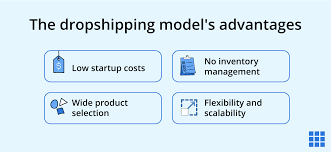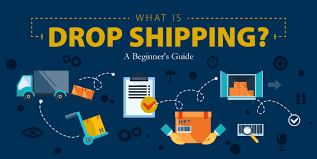
What is Dropshipping
Dropshipping is a business model where an entrepreneur sells products online without holding any inventory. Instead of purchasing products upfront, the dropshipping partners with suppliers who handle inventory, packaging, and shipping directly to the customer. When a customer places an order on the dropshipping online store, the seller forwards the order details to the supplier, who then ships the product.
The dropshipping earns the difference between the retail price and the wholesale price charge through the supplier. This model eliminates the need for upfront investment in inventory or a warehouse, making it a low-risk option for starting an online business.
How its work?
Dropshipping works by a straightforward process that requires three key parties,t he customer, the dropshipper, and the supplier.
Here is a detailed information about how dropshipping works:
- Set Up an Online Store: The dropshipper create an online store where the list products available by suppliers. These products are typically from third-party supplier or wholesalers.
- Customer Place an Order: A customer visit the dropshipper online store and make purchase. The dropshipper sets the retail price for the product, which is higher than the wholesale price offered through the supplier.
- Forward Order to Supplier: Once the order is placed, dropshipper forwards the customer order details and payment to the supplier. At this stage. the dropshipper only pays the suppliers wholesale price, keeping the difference as profit.
- Supplier Ships the Product: The supplier processes the order, pachages the product, and ships it directly to the customer. The dropshipper does not handle the products at all during this process.
- Profit Make: The dropshippers keeps the different between the price paid through he customer and the price charged by the supplier, which is their profit.
This process eliminates the need for a dropshipper to manage inventory, handle shipments, or deal with warehousing. It allows for a low-risk business model, customer service, and maintaining a good relationship with suppliers to ensure smooth operations.
Right Approaches To Dropshipping
To succeed in dropshipping, adopting the right approaches is essential. Here are some key strategies that can help you build a sustainable and profitable dropshipping business:
1. Select the Right Niche
Selecting a profitable niche is essential. Instead of selling overall products, focus on a particular niche with less competition and high demand. Research your target market thoroughly to find products with strong customer interest, however with limited competition. This allows you to cater a specific group, supporting you stand in a crowed marketplace.
2. Partner with Reliable Suppliers
Building a strong relationship with trustworthy suppliers is vital. Ensure they have a good track record for quality, timely shipping, and inventory management. A reliable supplier will help avoid stockouts, delays, or ppor-quality products, which can harm your store repute and customer experience.
Platforms like AliExpress, SalesHoo, or Spocket offer access to vetted suppliers.
3. Optimize Your Online Store
Create a professional, easy-to-use website that showcase your products effectively. Your online store should be easy to navigate, with clear product descriptions, high-quality image, and fast loading times. Invest in tools Shopify, WooCommerce, or BigCommerce to create a store that attracts and convert visitors.
4. Focus on Customer Service
Excellent customer service can make or break your business. Respond promptly to inquiries, resolve issues quickly, and ensure customer satisfaction. Always be transparent about shipping times, return polices, and product details. A happy customer is more likely to leave positive reviews and return for future purchases.
5. Invest in Effective Marketing
Without strong marketing, your dropshipping business won’t gain traction. Use strategies like social media marketing, content marketing, and SEO to drive organic traffic. Paid ads by platforms like Facebook, Instagram, and Google can also help bring in targeted customers. Work on building an email list and offering discount to convert visitors into loyal customer.
6. Track and Analyze Performance
Continuously monitor and analyze your store performance using analytics tools. Track important metrics such as conversion rates, customer behavior, and traffic sources. This data will help you identify areas that need improvement and adjust your marketing strategies for better results.
7. Automate and Streamline Operations
As your business grows, consider automating repetitive tasks like order processing, inventory updates, and email marketing. This will save your time and allow you to focus on scaling your business. Platforms like Zapier, Oberlo and automated email marketing platforms can streamline your operations.
8. Manage Customer Expectation
Be transparent about shipping times, which can sometimes be longer for dropshipping products, especially if suppliers are based overseas. Set clear expectations on your website regarding delivery time, return polices, and potential customs fees to avoid surprises for customers.
By following these approaches, dropshipping entrepreneurs can minimize risks and build a scalable, successful business. The right niche, solid supplier relationships, efficient marketing strategies, and excellent customer service are the key components of a thriving dropshipping store.
Advantage of Dropshipping

Here are some of the key advantage of Dropshipping
Low Costs for startup
Drop shipping does not require inventory so drop shipping requires minimal investment. Thus many stores are run from home without investment.
You can run a drop shipping business without worrying about inventory management or investment.
Wide Product Selection
by using dropshipping to offer your customers a wide range of trendy products. With unsold inventory to worry about, you can change the product catalog at will. You can sell a wide range of products without to stock the product.
Scalability
Low Inventory Costs
dropshipping model business offer without inventory business. Therefore you do not have need for investment for startup a dropshipping online store.
Low orders fulfillment costs
In drop shipping business model, the supplier takes care of inventory and its management, packaging and shipping, which means sellers don’t have to bear the warehousing or labor costs and all other costs which fulfilling orders. This helps maintain lower operational costs, allowing sellers to invest more in marketing, customer service, and growing their business.
Challenges in Dropshipping
Dropshipping is a profit-making business model, however it also comes with different challenges that enterpreneurs need to navigate carefully.
Blow is a detailed exploration of the most common challenges in dropshipping:
1. Low Profit Margins
One of the biggest challenges in dropshipping is operation with low profited margins. Due to high competition, sellers usually decrease prices to attract customers, leaving little room for profit. This means that even with significant sales volume, the earnings may not be substantial unless you find a method to stand out, such as by offering unique products.
2. Intense Market Competition
The dropshipping business model has a low barrier to entry, making it accessible to anyone. This results in intense competition, with many businesses offering identical products. Competing with established retailored and large ecommerce platform can be daunting, particularly for beginners who lack marketing experience and resources.
3. Dependency on Suppliers
Dropshipping heavily relies on third-party suppliers for inventory management, product quality, and shipping. If suppliers fail to deliver on time, give low-quality products, or run out of stock, it directly impacts your business reputation.
Since you don’t have control over these aspects, resolving such issues can be different and time-consuming.
4. Inventory and Shipping Issues
Since dropshipping don’t maintain their own inventory, keeping track of stock availability can be challenging. Suppliers may not update you promptly when products go out of stock. leading to canceled orders. Moreover, shipping become complex, particularly when working with multiple suppliers. Variation in delivery times and shipping costs can confuse customers and enhance dissatisfaction.
5. Customer Service Challenges
Handling customer services can be tricky in dropshipping because you are responsible for resolving complaints, processing returns, and issuing refunds, even by the fulfillment process is managed through suppliers. If a product is delayed, damaged, you must mediate between the customer and supplier, usually leading to delays in resolving issues and reduced customer trust.
6. Product Quality Concerns
Dropshippers usually sell product without personally inspecting them, which increases the risk of delivering poor-quality items to customers. Negative review and complaints about product quality can harm your business reputation and make it difficult to retain customers in the long term.
7. Payment and Refund Issues
The payment and refund process in dropshipping can be complicated. Since you rely suppliers to approve returns and issue refunds, delays are common. These delays can frustrate customers, damage your codability, and create additional challenges is maintain customer satisfaction.
8. High Marketing Cost
To attract customers, dropshipping usually invest heavily in marketing, particularly paid ads on platforms like Facebook and Google. But, if your ads don’t convert well, these costs can quickly add up, eating into your profits.
This makes effective marketing strategies essential to make sure a good returns on investment.
Conclusion
Dropshippin is a simply yet powerful business model that offers entrepreneurs to sell products online without managing inventory or handling shipping logistics. Through partnering with reliable suppliers, you can focus on creating an attractive online store, marketing your products, and providing excellent customer service. When a customer places an order, the supplier handle the packaging and shipping, making it a low-risk and cost-effective method to start an e-commerce business.
But, success in dropshipping involve strong supplier relationship, effective marketing strategies, and attention to customer satisfaction to stand out in a competitive market.

Frequently Asked Questions Dropshipping
Is dropshipping a big risk?
Dropshipping carries some risks, but it is generally considered lower risk compared to traditional retail models. Key risks include reliance on suppliers for product quality and fulfillment, potential for low profit margins, and competition in saturated markets. important factor for low risk is low investment.
what is the failure rate of dropshipping?
The failure rate of dropshipping can vary. widely based on various factors, including market conditions, the seller’s business strategy, and operational execution.
Is dropshipping worth it?
what is the advantages of Dropshipping?
Dropshipping offers various benefits, making it an attractive business model.
- First, it requires low initial investment and since you don’t need to purchase inventory manage a warehouse.
- Its provide flexibility as you can run the business from anywhere.
- it allows you to offer a wide range of products without worrying about storage.
- its reduce the risk of unsold inventory and lets you scale easily, focusing on marketing and customer services.
This makes dropshipping a cost-effective and convenient way to start an online business.





